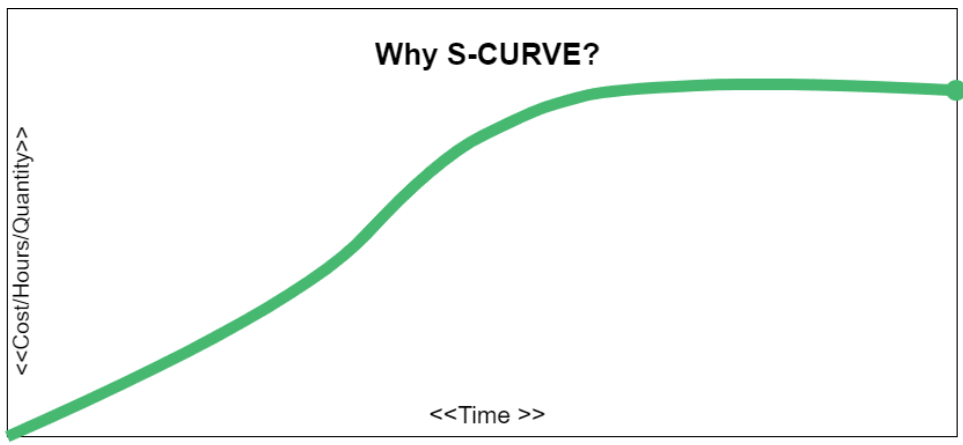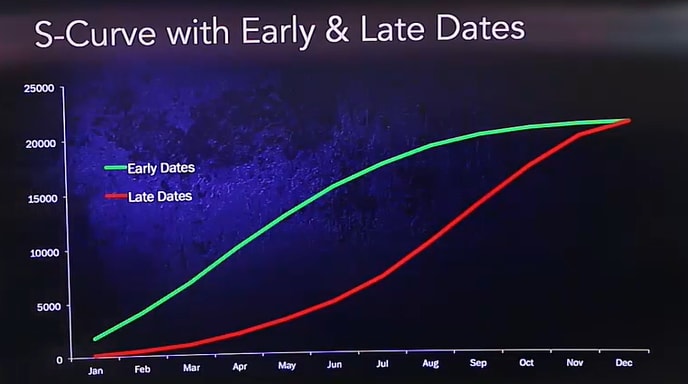If you’ve come across this blog, you likely found yourself searching the web, “What is an S-Curve?
Rather than getting lost in a storm of different business models and use cases that just don’t fit your needs, let’s simply address what you’re seeking—an understanding of S-curves or S- graphs in the scope of project management.
What does an S-curve represent?
An S-Curve’s definition is a mathematical graph that represents all of the data for a project. It’s called an S-curve because of the graph’s striking similarity to the 19th letter of the alphabet. This information plotted on the graph is typically the project cost or the number of hours worked compared against time— making it a useful tool for project managers to see the project progress at a high level.
At the start of the project, progress is slow and looks more like a straight line, whereas more rapid growth would be reflected with a sharper incline. Many internal and external factors through a project’s life cycle can impact the shape of an S- curve graph.
In the first stages, the project team is coming together, stakeholders are getting on board, and your time is spent planning rather than doing. Once the project is in full swing, growth in project activity — like man-hours — is significantly higher and the steep curve upward continues to grow to form the middle part of the S-shape. The point of maximum activity is called the inflexion point. Consequently, as the project begins to wind down and move to closure, the curve levels out again.

How does the S-curves help a manager make decisions?
An s-curve is helpful in monitoring project success because the real-time cumulative data of various project elements on it can be compared with projected data. You can examine the degree of alignment between two graphs to reveal the progress—or lack thereof— of whichever element is being studied. Here are a few more ways S-curves can serve a project manager well in the long term.
S-curves help you track project progress
Only 50% of PMs baseline their project schedule, which makes it difficult to monitor actual progress. By plotting an S-curve during project initiation, using estimates for data such as expected man-hours and cost, you have a baseline to track progress against. During the project lifecycle, the project manager can plot actual resource use to see how well it matches what’s expected. If there’s a gap between them, it’s an opportunity to make corrections on how resources are being used.
![]()
They enable you to predict when resources will be heavily utilized
Plotting your S-curve indicates when you expect the project to be most resource-intensive, such as when you need a cash injection or when activities are higher. This will make budget planning and resource allocation more accurate, as you will be able to clearly and confidently communicate when you need a large chunk of the project budget released by business stakeholders, or when you need to supplement your core project team with contractors.
They help you manage stakeholder expectations
S-curves can also help with keeping stakeholders engaged with your project, as they are a visual and intuitive way to explain to stakeholders the probable pace of work throughout the stages of the S-curve.
Explaining that progress is likely to be slow in the early stages of project execution before there will be a significant upturn in the amount of work can help manage stakeholder expectations that change might be rapid. It also keeps your team members on the same page for the deliverables of the product or service.
They enable you to plan for different schedule scenarios
Once your baseline S-curve is created, you can play with the inputs to identify the impact on the project. In such time-sensitive industries like marketing or advertising, smart and swift decisions are essential to staying relevant or dare we say, ahead of the curve.
This creates 2 curves that join at the start and finish and are known as a ‘banana curve,’ because of their shape. Project managers often estimate the earliest, and latest, a task can start in the schedule while not affecting overall duration. This indicates how much flex or ‘float’ there is in the schedule should things change during project execution.
As actual work is delivered, you can plot this against the banana curve. If the data points are close to the ‘latest date’ curve, it flags risk of project delay and prompts the project team to take action.

2 common uses of S-curves in project management?
Resource allocation planning
Plotting an S-curve using the variables of ‘expected man-hours’ and ‘time,’ shows how the project team size will need to flex over the project lifecycle. In the early stages of the project, when expected man-hours are low, you’ll likely just recruit a core project team. However, the recruitment process can take a long time, so it’s helpful to be able to plan when recruiting needs to start in order to have the right amount of people when required man-hours start to increase.
Expenditure vs. cash flow
Less than half of all projects are completed within budget, and careful monitoring and management of budgeted costs are crucial. This must be balanced with the fact that it’s rare for a project manager to get a hold of their whole project budget at once —it’s usually released in stages.
This allows project managers to either negotiate the schedule of when funds are going to be released, or delay any tasks that aren’t on the critical path until the next cash injection can be secured. If actual spend is lower than expected, there may be an opportunity to speed up the project timeline by securing extra resources to deliver work, or to increase the project scope.
How do you create an S-curve on monday.com?
It’s easy to create S-curves on monday.com because our Work OS contains all the information needed to create S-curves within the baseline schedule — expected project start and finish date, planned man-hours, and forecast project expenditure. We also easily integrate with Excel, so your board data can be organized and exported to use the line graph function to create your S-curve. The ‘x-axis’ will plot the project timeline and the ‘y-axis’ will plot the factor you’re interested in tracking, such as project cost.

During the project lifecycle, information is captured on the actual resources used. This can be used to plot your actual S-curve and any variance between that and the baseline curve identified. Action can then be taken to bring the project back on track.
For example, you can flag the problem to the right people by setting notifications to occur automatically if the project veers off track. Or, you can collaborate in real-time within the monday.com platform to brainstorm a solution to the problem.
S-curves are a simple and visual way to track project progress
When created strategically and optimized with the added features of a Work OS, S-curves are more than worth their while for project management. So, why not take your first step towards S-curve mastery with our high level project plan template.
